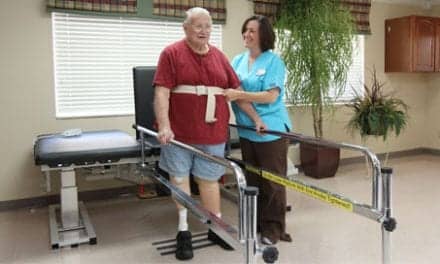The ever-evolving updates in the mobility arena allow clinicians to provide options to clients for an active, independent lifestyle.
by Katherine M. Collins, PT, DPT, ATP
Consumers continue to demand increased performance, comfort, and efficiency from their wheelchairs. They are more active and independent than ever before, using their chairs for work, leisure, sport, and many other activities. Manufacturers have been working to answer the challenge of durable, lightweight, sleek, efficient manual chairs and sturdy, aesthetically pleasing, high-end power chairs with improved electronic capabilities. Historically, the wheelchair paradigm has changed. Likely, the first chairs with crude seated surfaces and wooden wheels were built out of necessity. The earliest evidence of a traditional wheelchair, appearing to be a chair with wheels attached, is found in a Chinese engraving dated 535 AD. King Philip II of Spain had a special chair built for him in 1595, and in 1655 Stephan Farfler, a watchmaker and paraplegic, built the first three-wheeled “self-propelled” wheelchair. The three-wheeled chair would be the standard for many years to come. In 1867, wooden wheels were exchanged for iron ones and 8 years later hollow tires were added. In 1881, rubber tubed wheels, adjustable footrests, and reclining backs were made for increased efficiency and a smoother ride. In 1894, the first patented wheelchair in the United States was created. Subsequently, over the next 50 years, spokes, horsepower, folding frames, and electric wheelchairs were developed. In 1980, a power chair with a built-in microcomputer was developed.1 This was the beginning of a new era. Recent updates in frame materials, frame designs, power bases, drive systems, and accessories have created increased access of all areas of life for end users.
The Evolution of the Frame
Frame materials have changed drastically since the invention of the wheelchair, moving from wood, Indian reed, chrome alloy, tubular steel, aluminum, titanium, and even carbon fiber. Several product lines have made recent updates, including one manufacturer that has begun to include 7000 series aluminum for all of its manual models. Previously, the manufacturer used 6000 series aluminum in several of its manual wheelchairs, but this higher grade aluminum—previously used in the aerospace industry—is now filtering into the world of wheelchairs. It is important to note that this material offers a stiffer ride but tends to be slightly more brittle. A dual tube frame is more readily available in aluminum, and at least one rigid frame model offers a titanium upgrade. The availability of both aluminum and titanium frames is helping increase options for manual models overall. Worth noting also as a fairly new entry to the marketplace is a titanium dual tube chair designed to offer full adjustability.
Frame designs also have changed from the bed on wheels depicted on a Greek vase in 530 BC to sleek and aerodynamic frames that come in a wide variety of colors. Suppliers, therapists, and consumers of wheelchairs have requested more flexibility to create a custom fit, and one response from the manufacturing community was the appearance of several “no charge” options. Examples of these options include increased frame length, a depth adjustable back frame, and build-by-order rigid frame chairs. These options aim to ensure a more unique fit to each patient and their diverse needs. Also fresh on the scene is a transit option on an ultra-lightweight model. This option features an integrated locking fold-down back with an integrated locking mechanism. A tilt-in-space chair that features a dual arc system incorporating all internal ball bearings rather than plastic sliders is also now available. This design creates a secure tilt that feels more natural and automatic than previous versions of tilt-in-space technology. Frame improvements continue to evolve and create the safest, most efficient manual chair frames to date.
Built to Empower
Power wheelchair technologies, in terms of wheelchair bases, drive systems, and accessories, also have changed. Recent updates among the marketplace include a model that offers 6-inch casters and a new fork assembly that allow the casters to spin more freely. Adjustable arm options for mounting joysticks and alternative controls, as well as cell phone and tablets, are also now available via a modular linking system where rods can be connected to joints in chosen angles. The system offers rigid fixation in all directions, allowing nearly limitless positioning options. These rods and joints are engineered so they may be quickly and easily adjusted in the field to allow for modifications to positioning and placement of a joystick. Among some power wheelchair models, a direct backrest frame option and a new hybrid cushion are also available. The direct backrest frame is a specialized aftermarket frame designed to allow the mounting of backrests from various manufacturers, ranging in width from 14 inches to 20 inches. The frame hardware is able to mount directly to the backrest. Utilizing mounting brackets and linkage disks creates an adjustable mount that increases seat depth if necessary. The linkage disks can be rotated to allow up to 10 degrees of backrest angle. Also, a power wheelchair manufacturer recently joined together with a manufacturer of shape fitting products to create an adjustable skin protection and positioning cushion. This cushion is designed to be easily adjustable, allow for pelvic support with removable seat wedges, and provide a skin protection component under the bony prominences of the seated surface.
Other developments continue to emerge from the wheelchair manufacturing arena, including the addition of cantilever arms, elimination of endomorph and mesomorph back canes, and increased adjustability that can be completed with the consumer in the chair. This style of cantilever arms can be internally and externally rotated to allow for safe and appropriate upper extremity positioning. Previously, there was an increased cost to order a back width that was different than the seat width, but at least one manufacturer offers this as a no charge option that allows for more customizable rehab seating. Similarly, whereas clients typically have to transfer out of chairs for modifications to be made, a system has been designed where fine adjustments can be made while the wheelchair user is in the chair, increasing efficiency. Late last year, the market also saw the entry of a system engineered to accommodate a 450-pound weight limit that can be equipped with multi power options including tilt, recline, and power elevating legs.
Another recent enhancement to appear among power wheelchair models is a 16-inch seat to floor height and a 12-inch seat elevator that allows a wide range of reach as well as face-to-face interaction. A transfer-friendly power footplate extend feature is also now available on some power mobility devices.
A Driving Force for Independence
Electronics and drive controls also have been evolving. A total control head array system is the new form of alternative control for drive systems, and made to handle more like a proportional joystick with fewer sensor faults. It has excellent adjustability with articulating arms with multiple lengths. A fully programmable head array that uses USB connection with the clinician’s or supplier’s laptop for programming is available, and many modifications can be made. Some options include the ability to add more switches or embed speakers into the headrest. More traditional forms of driving with a joystick are still offered, with Bluetooth built into controllers to offer access to computer, tablet, and phone functions for both Apple and Android. This option was previously only offered in the enhanced display used with alternative drive modes.
Manual and power wheelchairs continue to evolve to accommodate the safety, efficiency, and aesthetic needs of active users. The challenge continues to be reimbursement. Manufacturers are doing what they can to accommodate clients’ needs with the knowledge that acquiring funding can be difficult. Some measures include offering custom fit with no charge options such as depth adjustable frames and more frame length. Adding adjustability to frames can increase the length of time a person can use a chair, allowing for changes in body size, specifically in pediatrics. In some cases, Bluetooth capabilities in drive controllers are offered at no additional cost. They also have added transit securement kits, an attendant control when multiple power options are medically necessary, and two free accessories of the client’s choice with no up charge. Strong documentation by clinicians, justifying medical necessity, is imperative to assisting consumers to acquire the necessary equipment. Conscientious and thorough explanations of the client’s individual needs are imperative.
The updates in frame materials, frame designs, power bases, drive systems, and accessories continue to evolve. It is important for clinicians and suppliers to be aware of these changes in order to be able to offer the safest, most efficient, and most appropriate equipment to each client. It is likely that funding will continue to be challenging, but with continued development from manufacturers and an understanding of the diverse needs for each consumer, clinicians can continue to offer many options to encourage independent, active lifestyles for their clients. RM
Katherine M. Collins, PT, DPT, ATP, is the Seating and Positioning Specialist at Madonna Rehabilitation Hospital. Collins earned her DPT in 2006 from the University of Nebraska Medical Center. She started at Madonna in January 2012 following 4 years at Children’s Hospital and Medical Center and 2 years with Quality Living Inc practicing school-based therapy. Collins specializes in seating and positioning and mobility, including manual and power chairs, pressure mapping, power assist mobility, and custom seating. She sees patients of all ages with a wide range of diagnoses including spinal cord injury, traumatic brain injury, CVA, neurologic impairments, trauma, and orthopedic impairments. For more information, contact [email protected].
Reference
1. Sawatsky Bonita (June 13, 2002). Wheeling in the New Millennium: The history of the wheelchair and the driving forces in wheelchair design today. Wheelchairnet. http://www.wheelchairnet.org/wcn_wcu/slidelectures/sawatzky/wc_history.html. Accessed December 26, 2013.




